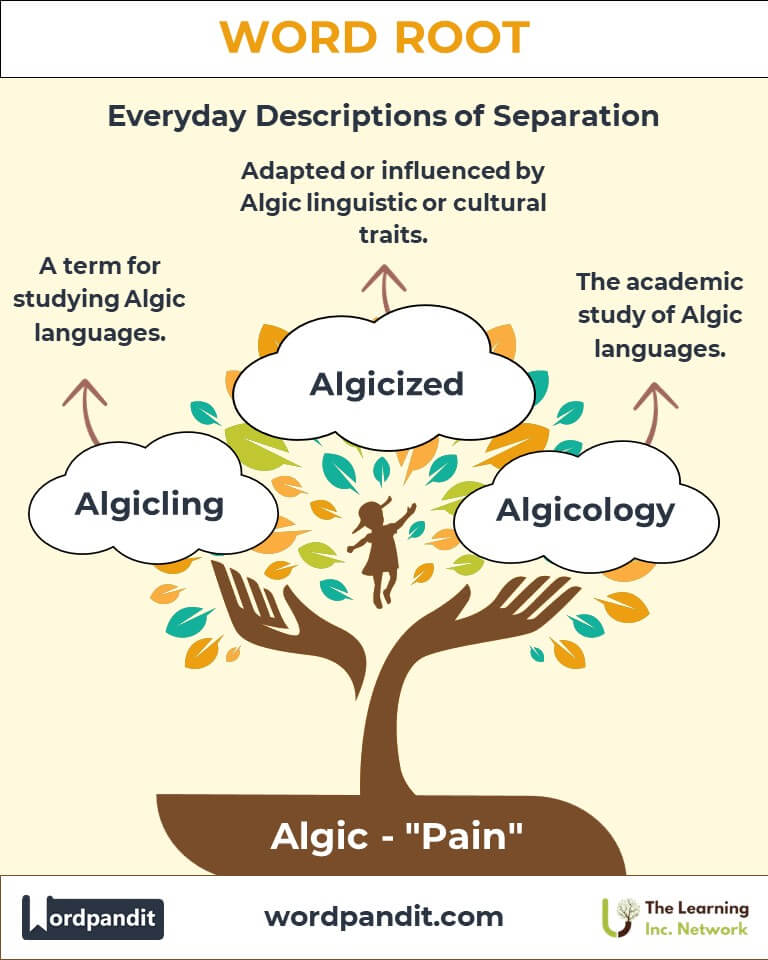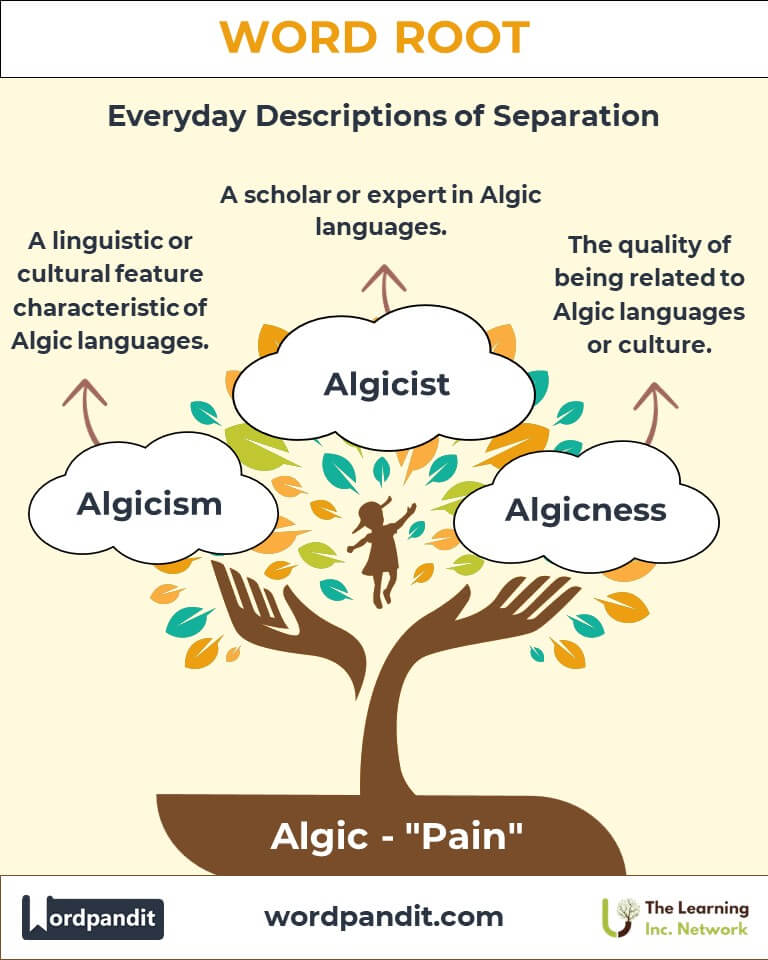Algic: The Linguistic Connection to Algonquian Cultures
Explore the word root "Algic," tracing its origins in linguistics and culture to its application in describing a diverse family of Indigenous languages and traditions across North America. This journey uncovers the historical significance, linguistic depth, and cultural richness of Algic-based terms and their evolution over time.

Table of Contents
- Introduction: The Diversity of "Algic"
- Etymology and Historical Journey
- Mnemonic: Unlocking the Power of Algic
- Common Algic-Related Terms
- Algic Through Time
- Algic in Specialized Fields
- Illustrative Story: "Algic" in Action
- Cultural Significance of the Algic Root
- The Algic Family Tree
- FAQs about the Algic Root
- Test Your Knowledge: Algic Mastery Quiz
- Conclusion: The Living Legacy of Algic
1. Introduction: The Diversity of "Algic"
What unites the languages of the Cree, Ojibwe, and Blackfoot peoples? The answer lies in the word root "Algic." Pronounced "al-jik," this term refers to the Algic language family, a grouping of Indigenous languages across North America. The Algic root has profound cultural and linguistic significance, bridging diverse traditions and histories through language.
Derived from linguistic studies of the 19th century, "Algic" serves as a linguistic umbrella, connecting communities through shared linguistic traits while celebrating their individual uniqueness. Its study offers invaluable insights into the human capacity for communication, culture, and survival.

2. Etymology and Historical Journey
The term "Algic" was first coined by linguist Henry Rowe Schoolcraft in 1839. Combining "Algonquin" (a prominent language and cultural group) with "-ic," Schoolcraft sought to define a broader linguistic family encompassing the Algonquian, Wiyot, and Yurok languages.
Although initially controversial, the grouping has since been recognized as a major linguistic family, encompassing languages spoken from the Great Plains to the northeastern woodlands and the Pacific Coast. The term "Algic" symbolizes the interconnectedness of these language groups, despite their geographical dispersion.
3. Mnemonic: Unlocking the Power of Algic
To remember "Algic," think of the word as a bridge uniting cultures through language. Picture a vibrant map of North America where communities, each speaking a unique dialect, are linked by a common linguistic thread. This imagery reinforces the meaning of Algic as a unifying force in linguistics.
Mnemonic Device:
“Algic: A linguistic bridge connecting the Algonquian nations and beyond.”
4. Common Algic-Related Terms
- Algonquian (al-gon-kwee-an): A subgroup of the Algic language family, including Cree, Ojibwe, and others.
Example: "The Algonquian languages are spoken by many Indigenous peoples in Canada and the United States." - Cree (kree): One of the largest Algonquian-speaking groups in North America.
Example: "The Cree people have a rich oral tradition and a unique syllabary for writing." - Ojibwe (oh-jib-way): A widely spoken Algonquian language with distinct dialects.
Example: "Ojibwe songs and stories preserve the community's history and values." - Wiyot (wee-yot): A California-based language included in the Algic family.
Example: "The Wiyot language, though endangered, is undergoing revitalization efforts." - Yurok (yoo-rok): Another California-based Algic language, known for its complex verb forms.
Example: "The Yurok people use their language to teach ecological knowledge."
5. Algic Through Time
- 19th Century: Initial recognition of Algic as a linguistic family emphasized shared grammatical structures.
Impact: Early linguistic studies helped highlight the diversity of Indigenous languages. - 20th Century: Advances in linguistics allowed for deeper analysis of Algic phonetics and syntax.
Impact: Researchers identified relationships between distant Algic languages, fostering appreciation for their complexity. - Modern Day: Revitalization programs focus on preserving and teaching Algic languages to younger generations.
Impact: Efforts such as language camps and digital tools are reconnecting communities with their linguistic heritage.
6. Algic in Specialized Fields
- Linguistics: Algic serves as a cornerstone for understanding language evolution and structure.
Example: Comparative studies reveal patterns in verb morphology across Algic languages. - Anthropology: Algic languages are key to studying cultural narratives and practices.
Example: Stories in Cree and Ojibwe provide insights into Indigenous cosmology. - Education: Bilingual education programs use Algic languages to promote cultural identity.
Example: Immersion schools help preserve languages like Ojibwe while teaching modern curricula. - Technology: Digital tools, such as apps and online dictionaries, aid in the revitalization of Algic languages.
Example: Interactive games in Yurok teach children foundational vocabulary.
7. Illustrative Story: "Algic" in Action
Dr. Leona, a linguist specializing in Indigenous languages, was called to help a community preserve their nearly forgotten Wiyot language. By analyzing old recordings and texts, she reconstructed grammar and vocabulary. She collaborated with elders to create learning materials, blending traditional stories with modern teaching methods. Her work not only preserved the language but also reignited cultural pride and inspired a younger generation to embrace their heritage.
8. Cultural Significance of the Algic Root
Algic languages carry the history, knowledge, and values of their speakers. From oral storytelling traditions to ceremonial songs, these languages encapsulate the worldview of their communities. Cultural revitalization efforts underscore the role of language as a vessel of identity, ensuring that the wisdom of the past informs future generations.

9. The Algic Family Tree
- Algonquian: Includes Cree, Ojibwe, and Blackfoot.
Example: Algonquian languages are known for their rich verb morphology. - Wiyot: Spoken in Humboldt County, California.
Example: Wiyot's distinct vocabulary reflects its coastal environment. - Yurok: Also native to California, it emphasizes ecological and spiritual concepts.
Example: Yurok verbs capture intricate relationships between nature and human activity.

FAQs About the Algic Root
Q: What does "Algic" mean, and where does the term originate?
A: "Algic" refers to a linguistic family that includes the Algonquian, Wiyot, and Yurok languages. The term was coined by linguist Henry Rowe Schoolcraft in 1839, blending "Algonquin" with "-ic" to describe a larger language family. It emphasizes the shared traits of these languages while celebrating their diversity.
Q: Are Algic languages still spoken today?
A: Yes, some Algic languages, like Cree and Ojibwe, are widely spoken and have significant speaker populations. However, others, like Wiyot and Yurok, are endangered and rely on revitalization programs to keep them alive.
Q: What are some unique characteristics of Algic languages?
A: Algic languages are known for their complex verb morphology, which often encodes detailed information about time, space, and relationships. For example, Yurok verbs can describe intricate ecological and human interactions, reflecting the worldview of their speakers.
Q: How are endangered Algic languages being preserved?
A: Communities and linguists collaborate on language preservation through digital resources, immersion schools, and recording projects. Tools like mobile apps, online dictionaries, and cultural workshops play an essential role in passing these languages to new generations.
Q: What role does storytelling play in Algic languages?
A: Storytelling is central to Algic cultures, serving as a means to preserve history, transmit values, and teach ecological knowledge. These oral traditions are often deeply embedded in the languages, with specific terms and structures designed for storytelling.
Test Your Knowledge: Algic Mastery Quiz
1. What does "Algic" refer to?
2. Which language is part of the Algonquian subgroup?
3. What is unique about Yurok verbs?
4. Who coined the term "Algic"?
5. What tools are used for language revitalization?

10. Conclusion: The Living Legacy of Algic
The Algic root encapsulates a linguistic and cultural richness that spans centuries and continents. As these languages are preserved and revitalized, they continue to inform our understanding of human history, culture, and communication. From fostering connections across communities to advancing our knowledge of linguistic diversity, Algic serves as a testament to the enduring power of language to shape and sustain human identity.
By exploring Algic, we honor the voices of the past and ensure they resonate in the future. Let the study of Algic inspire ongoing efforts to celebrate and preserve linguistic diversity worldwide.












So much helpful for English learners with the help of these root words that one can easily guess the meaning .